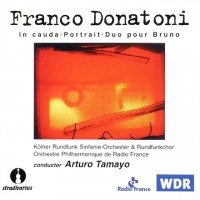Franco Donatoni
|
Grant Chu Covell [July 2000. Originally appeared in La Folia 2:5.] Franco DONATONI: In cauda, Portrait, Duo pour Bruno. Kölner Rundfunk Sinfonie-Orchester & Rundfunkchor, Orchestre Philharmonique de Radio France, Arturo Tamayo, (cond.); Elizabeth Chojnacka, harpsichord. Stradivarius STR 33541. Hooray, hooray! A new Donatoni CD! Franco Donatoni writes exquisitely crafted intense music. He is one of few living composers who can write a good non-diatonic melodic line full of color and contrast. His music is lyric yet dissonant, full of energy, and given to violent outbursts. (I’ve heard that Donatoni himself is something like this.) Intricate highly ornamented lines are always clearly articulated, and several simultaneous different lines and textures are always undulating. Donatoni’s music seems barely held in restraint and on the verge of rupturing, and contradictions are always emerging and retreating. Donatoni is programmed frequently by contemporary music ensembles in Europe, but recordings are infrequent. Most available Donatoni CDs feature works for small groups or solos. This is difficult music for any sized ensemble. This CD presents three works with orchestra, one with harpsichord soloist, another with chorus. These are live recordings (made in 1991 and 1996) complete with quickly disappearing coughing and audience noise. Despite its complexity and dissonant vocabulary, Donatoni’s choral writing in In cauda (1982, text by Brandolino Brandolini d’Adda) reaches back through Verdi to Gesualdo in its directness of expression. Donatoni tends to treats the chorus as a whole, like a crowd, and not broken down into infinitesimal parts as is the current tendency in contemporary choral writing. This is a powerful three-movement work that Donatoni calls a “lay requiem.” Assertive choral writing is contrasted with intricate lines and aggressive percussion. The first movement propels forth with chorus and percussion totally without introduction or preparation. The climax of the second and third movements is terrifying: percussion and chorus swell, the orchestra providing punctuation. And the work stops as suddenly as it started. Donatoni has since written In cauda II and In cauda III. Portrait (1975-76) is for harpsichord and orchestra. I have raved about Elizabeth Chojnacka elsewhere: she is a dynamic harpsichordist and her repertoire is almost exclusively contemporary. Available CDs find her playing Ferrari, Ligeti, Mache, Nyman and Xenakis (I think the de Falla concerto is her most “classic” repertoire). Harpsichord and orchestra implies an imbalance of forces, exactly the sort of thing Donatoni is all about. Harpsichord and orchestra banter for more than eighteen minutes churning through angular material and textures. The harpsichord is pointillistic by nature, and the orchestra continually responds with often dreamy, slightly muddled textures. Boulez prides himself on contrasting sustained material versus sharply attacked material, but I think Donatoni does a more convincing, less intellectual and more visceral job. The CD is rounded off with the full orchestral work Duo pour Bruno (1974-75), a memorial for the conductor/composer Bruno Maderna. Someone should pair this work with Boulez’ memorial, Rituel in Memoriam Maderna and take a piece of Maderna’s for an exciting program of philosophically different composers and their works. Constantly shifting rhythms and accents obscure a steady pulse, and lush and vibrant gestures whip by obscuring the work’s formalism. Other Donatoni CDs include one on Erato where Donatoni is paired with Ligeti (First Book of Piano Etudes and the Horn Trio) and is represented by Tema and Cadeau performed by members of the Ensemble InterContemporain conducted by Boulez (Erato 2292-45366-2). One of my favorite Donatoni works is the difficult Lied, which opens with several pairs of instruments playing a jerking chorale, each pair in minor seconds. This dissonance permeates through the entire work and in Donatoni’s skilful instrumentation hardly sounds like dissonance at all, just some mildly itchy coloring. Stradivarius STR 33315 with the Gruppo Musica Insieme di Cremona under Andrea Molino offers For Grilly, Lied, Lumen Ash, Arpege and L’Ultima Sera. Another representative disc offers Spiri, Eco, Ombra, Diario and Lame on Harmonic Records H/CD 8616. Included are works for small ensembles, for solo contrabass clarinet, and one for solo cello.
[More
Donatoni]
[Previous Article:
Composed and deComposed: Music of Our Centuries]
[Next Article:
Michael Nyman, Pierre Henry, and the CEC]
|
